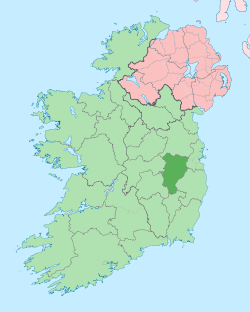River Rye (Ireland)
| Rye | |
|---|---|
| Country | Ireland |
| Basin | |
| Main source |
Garadice, County Meath ~122 m (400 ft) |
| River mouth | Irish Sea at Dublin Bay via River Liffey |
| Basin size | 59.7 km2 (23.1 sq mi) |
| Physical characteristics | |
| Length | ~8 km (5.0 mi) |
| Discharge |
|
| Features | |
| Tributaries |
|
The River Rye or Ryewater (Irish: Abhainn na Rí[1]) is a tributary of the River Liffey. It rises in County Kildare, flowing south-east for 12 miles. Although the river has been drained it is generally fast flowing over a stoney bottom.[2] The Rye's major tributary is the Lyreen.
Route

The Rye runs north of Kilcock and Maynooth. Maynooth Castle is built between the Lyreen and another smaller tributary of the Rye.[3] The Lyreen and Rye meet to the east of Maynooth and flow on through the estate of Carton House. In the estate, the river was widened to form an ornamental lake within the Georgian parklands, further enhanced by an ornamental bridge and boathouse.
The river then flows behind Intel Ireland where Intel have been monitoring the water quality since 1989.[4]
Near Louisa Bridge in Leixlip the waters from the Leixlip Spa flow into Rye River. The Rye then flows under the Royal Canal, which is carried in the Leixlip aqueduct almost 100 feet (30m) above. The aqueduct is in fact an earth embankment, which took six years to build in the 1790s.[5]
The Rye then descends into the heart of Leixlip. Here the river was harnessed by mills. In 1758, the site was used as a linen printing mill.[6] Later the Rye Vale distillery was built, producing more than 20,000 gallons of whiskey annually in 1837.[7] The distillery finally closed for good in the 1890s[8] and the distillery has since been converted into apartments.[9] The Rye then flows under the Rye Bridge to the confluence with the Liffey near the existing Boat House in Leixlip demesne.[10]
Fishing
The river has stocks of brown trout and pike. Angling is available at the Lyreen Angling centre, Leixlip and District Angling Association and Carton House
References
- ↑
- ↑ Fishing Information: Rye Water
- ↑ Kildare Local History: Manor Mills
- ↑ Intel celebrates the remarkable Rye River
- ↑ The Royal Canal Route: Leixlip to Kilcock
- ↑ Leixlip Chronology 1750-80
- ↑ A Topographical Dictionary of Ireland, 1837
- ↑ Hidden Gems:Rye vale Distillery Leixlip
- ↑ Industrial Heritage Ireland: Leixlip Distillery
- ↑ Leixlip around 1798
External links
- Trout Angler: Rye Water
- Intel Ireland and the Rye
- Intel Report: The Remarkable Rye River
- National Parks and Wildlife Service: Rye Water/Carton SAC
